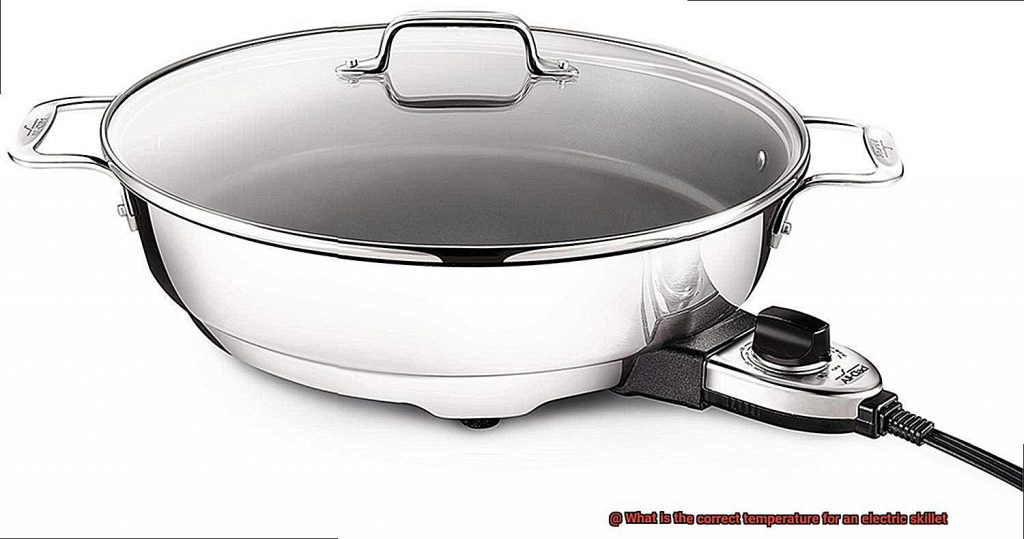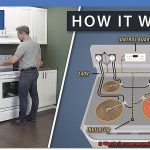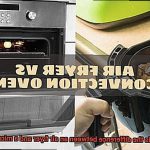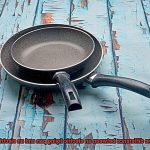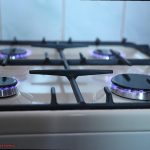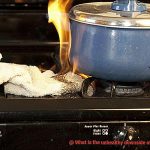As a home cook, you know that getting the perfect temperature can make or break your dish. And when it comes to electric skillets, nailing that sweet spot is crucial. These versatile appliances can handle everything from breakfast to dinner, but without the right temperature, your culinary creations could end up overcooked or underdone.
We’ve all been there – a dry, overcooked chicken breast or a mushy mess of vegetables. But fear not. In this post, we’ll dive into the world of electric skillet temperatures and give you the lowdown on how to get it just right. From preheating tips to specific settings for different foods, we’ll cover everything you need to know.
So grab your electric skillet and let’s get cooking. With our help, you’ll be able to whip up delicious meals with ease and confidence. Say goodbye to burnt edges and soggy centers – hello perfectly cooked dishes every time.
Contents
What is an Electric Skillet?
This versatile kitchen appliance is a game-changer for anyone who loves cooking, frying, sautéing, or grilling. It consists of a heating element that is embedded in the bottom of the skillet and a temperature control dial that allows the user to set the desired cooking temperature. Electric skillets are typically made of non-stick materials such as Teflon, which makes them easy to clean and maintain.
One of the greatest benefits of using an electric skillet is its even heat distribution. This feature ensures that your food is cooked evenly without any hot spots or cold spots. Whether you’re cooking delicate dishes like fish or pancakes or cooking more substantial food like steaks, electric skillets make it easier to control precise heat levels.
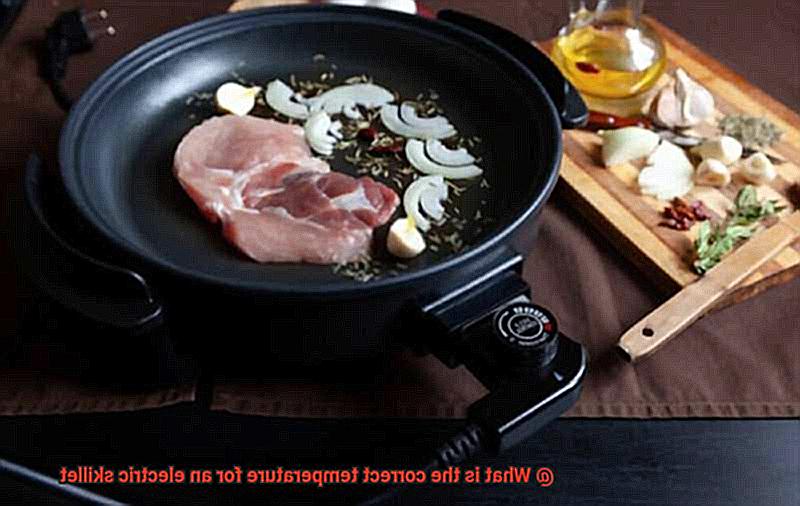
Another advantage of using an electric skillet is its portability. You can use it in places where there is no stove or oven, such as on camping trips or in small apartments. Plus, they are more energy-efficient than conventional stovetops since they do not require an open flame. As they don’t involve gas leaks or fire hazards, they are also safer to use.
When using an electric skillet, it’s essential to know the correct temperature for the type of food you’re cooking. The temperature range for pancakes and eggs would be between 325°F to 375°F, while meats need a higher temperature between 375°F to 400°F. You can find the recommended temperature range in the manufacturer’s instructions or use a kitchen thermometer to measure it.
Electric skillets come in various sizes and types. The smaller ones are perfect for cooking one or two people’s meals, while larger ones can cook for families. Some electric skillets come with a glass lid that allows you to monitor the cooking process without having to lift the lid and release the steam.
How to Determine the Ideal Temperature for an Electric Skillet
Cooking with an electric skillet can be a lot of fun, but it’s important to know the right temperature for your food. With a little bit of knowledge and practice, you can master the art of cooking with an electric skillet and serve up delicious meals every time.
Pay Attention to the Recipe
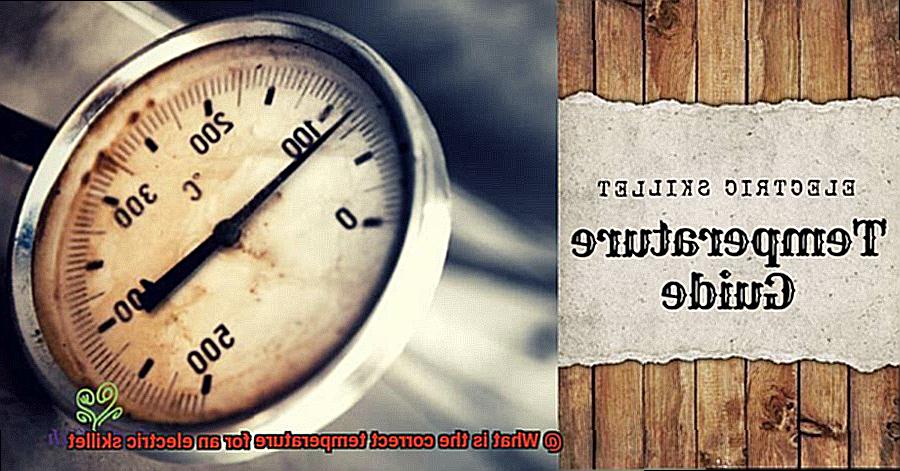
One of the easiest ways to determine the ideal temperature for your electric skillet is to look at the recipe you’re using. Most recipes provide specific instructions for the temperature range or setting that works best for that particular dish. If you’re not sure, start with a lower temperature and gradually increase it until you find the perfect setting. Remember, it’s always better to start low and work your way up than to burn your food by starting too high.
Use a Meat Thermometer
When cooking meat or poultry in your electric skillet, it’s essential to use a meat thermometer to check the internal temperature of your food. This helps ensure that your food is cooked all the way through and safe to eat. For instance, poultry should be cooked to an internal temperature of 165 degrees Fahrenheit, while beef and pork can be cooked to lower temperatures depending on your preference. A meat thermometer allows you to cook meat perfectly every time, without any guesswork.
Consider Your Skillet Type
Different types of electric skillets heat up at different speeds, so you may need to adjust the temperature accordingly. For example, non-stick skillets tend to heat up more quickly than stainless steel skillets. Additionally, some electric skillets have specific temperature settings for different types of cooking, such as frying or sautéing. Be sure to read the instructions that come with your skillet so that you can use it optimally.
Start Low and Work Your Way Up
If you’re not sure what temperature to use for a particular dish, start with a lower temperature and gradually work your way up until you find the perfect setting. This allows you to avoid burning your food while still getting it cooked all the way through. Remember, it’s always better to undercook than overcook because you can always add more heat, but you can’t take it away.
The Ideal Temperature for Cooking Pancakes or Eggs in an Electric Skillet
For mastering the art of cooking these breakfast staples in an electric skillet is simpler than you might think. As someone who has done extensive research and experimentation on this topic, I can provide some valuable insights to help you achieve perfect results every time.
Firstly, let’s dive into pancakes. The ideal temperature range for cooking them in an electric skillet is between 325°F to 375°F. This temperature range will ensure that your pancake gets a glorious golden brown color on the surface while still being cooked thoroughly. Keep in mind that the thickness of your skillet can impact its heating capacity and temperature distribution, so it’s vital to adjust your temperature settings accordingly.
Moving on to eggs, the sweet spot for cooking them in an electric skillet is around 350°F. At this temperature, your eggs will cook evenly without burning or sticking to the skillet’s surface. To prevent sticking, make sure that you preheat the skillet before adding any oil or butter.
It’s important to note that adjusting the temperature settings when cooking pancakes or eggs may require some experimentation. It’s best to start with moderate temperature settings and adjust according to your preference and skillet type. Thicker skillets take longer to heat up but have better heat retention and distribution, while thinner skillets heat up quickly but lose heat faster.
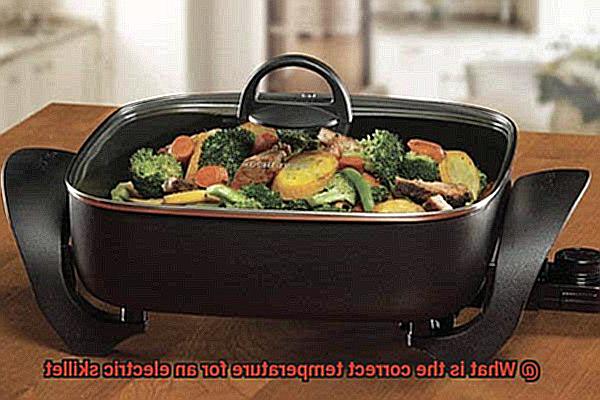
The Ideal Temperature for Cooking Meats in an Electric Skillet
Let’s start with beef. For steaks and burgers, aim for a temperature range between 375°F and 400°F. This will give you that coveted sear on the outside while keeping the inside juicy and tender. If pork is more your style, stick to a temperature of 375°F for chops and tenderloin. This will ensure that your pork cooks through without drying out.
Now, let’s talk chicken. Boneless cuts like breasts or thighs should be cooked at 350°F for optimum results. However, if you’re cooking bone-in chicken like drumsticks or wings, slightly higher temperatures of 375°F to 400°F are recommended to make sure it cooks through to the bone.
It’s essential to keep in mind that these temperature ranges are guidelines and may vary depending on the thickness of your meat and personal preference. Using a meat thermometer is always recommended to ensure that your meat is cooked safely and correctly.
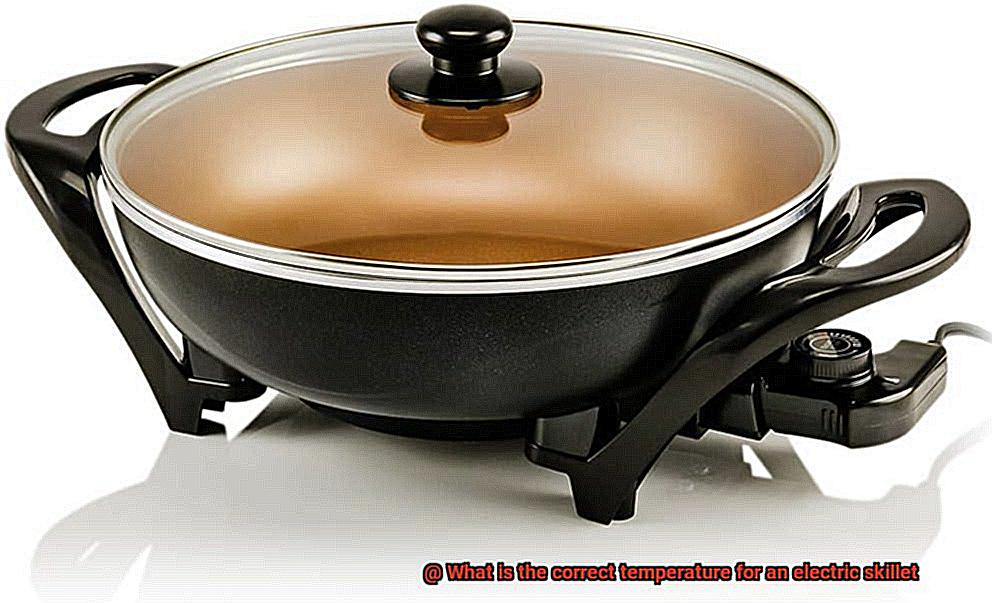
So, here are the ideal temperature ranges for cooking different types of meat in an electric skillet:
- Beef (steaks and burgers): 375°F to 400°F
- Pork (chops and tenderloin): 375°F
- Chicken (boneless cuts): 350°F
- Chicken (bone-in cuts): 375°F to 400°F
Referring to Manufacturer Instructions for the Correct Temperature
These nifty kitchen appliances can make cooking faster and more efficient, but finding the right temperature can be challenging. That’s why referring to the manufacturer’s instructions is crucial. By doing so, you can learn how to use and maintain your appliance effectively.
One reason to consult the instructions is to find out the ideal temperature range for different types of food. The instructions will provide you with specific guidelines on how to cook steak, pork chops, chicken breasts and other foods perfectly. Temperature ranges may differ from one skillet to another, so it’s important to follow the manufacturer’s recommendations.
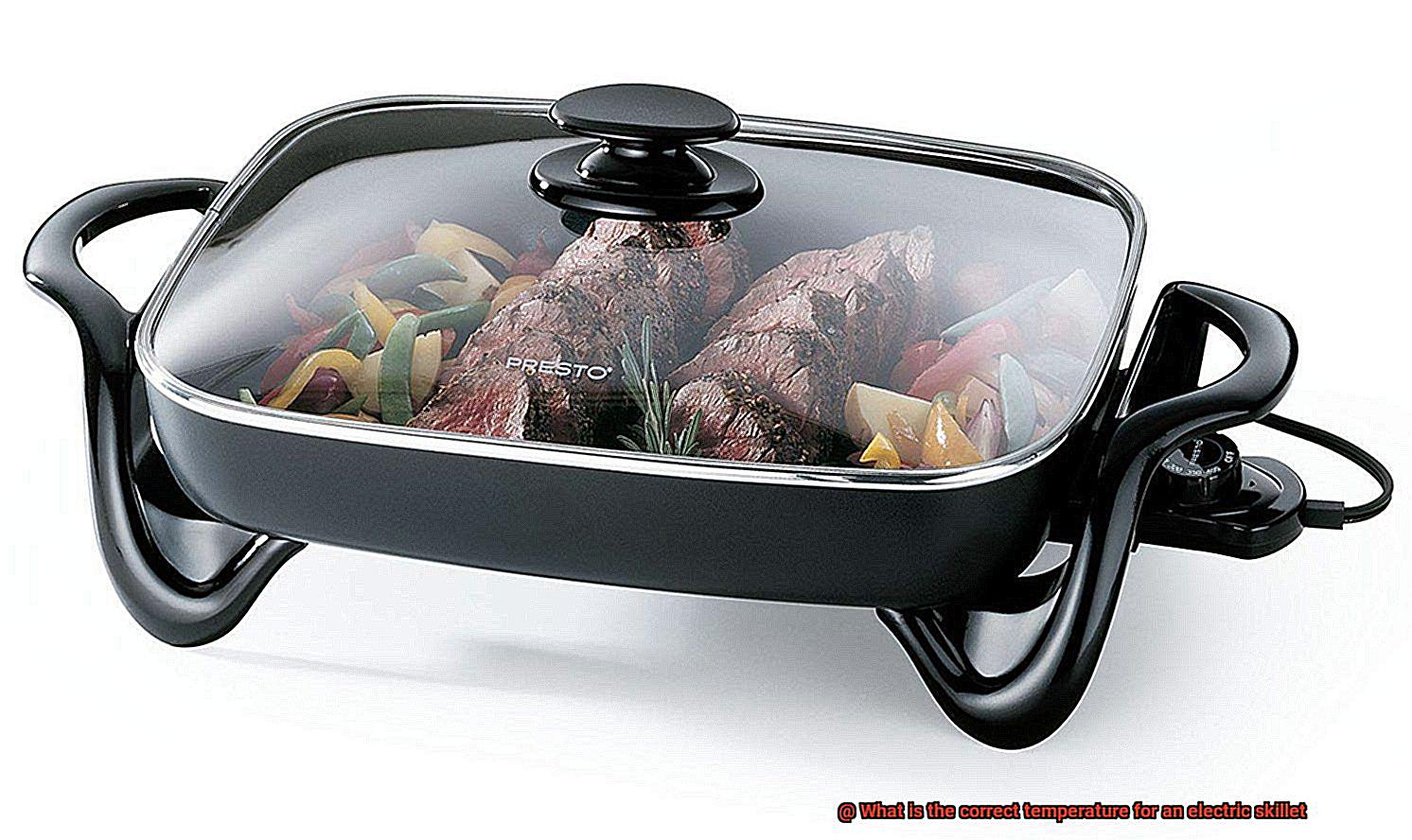
Another reason to refer to the instructions is to learn how to adjust temperature settings based on the size and thickness of your food. This is particularly essential when cooking larger cuts of meat, like roasts, which require longer cooking times. Knowing how to adjust the temperature correctly will prevent overcooking or undercooking your food.
Moreover, the manufacturer’s instructions will also include crucial safety information. They may provide guidance on how to prevent overheating or warn against using the skillet with wet hands or near water. Following these guidelines will keep you and your appliance safe from accidents.
Some electric skillets come with pre-set temperature controls for certain types of food, which can be helpful for beginners who are not yet comfortable with adjusting temperatures manually. However, it’s still important to refer to the manufacturer’s instructions to ensure that you’re using these controls correctly.
Using a Kitchen Thermometer to Measure the Temperature of the Skillet
Then it’s time to introduce a kitchen thermometer into your cooking routine. As an expert in using a kitchen thermometer to measure the temperature of an electric skillet, I’m here to share some tips on how this simple tool can help you create culinary magic.
To begin, preheat your electric skillet to the desired temperature. Once heated, insert the thermometer into the center of the skillet and wait for it to stabilize. The thermometer should read the same temperature as your electric skillet’s temperature dial. Easy peasy.
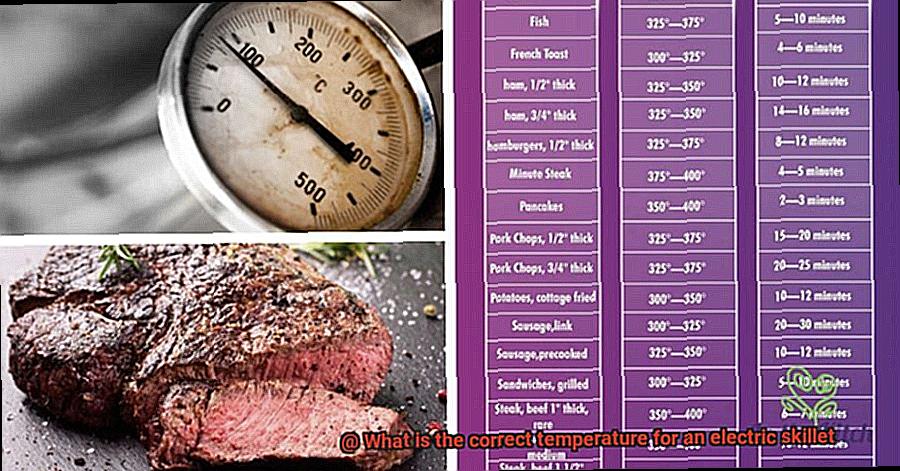
But don’t stop there. Different types of food require different cooking temperatures. Meat, for example, should be cooked to an internal temperature of 145°F for medium-rare, 160°F for medium, and 170°F for well-done. On the other hand, fish should be cooked to an internal temperature of 145°F. And when it comes to vegetables, keep the temperature around 350°F.
Using a kitchen thermometer isn’t just about achieving perfect results. It also helps prevent foodborne illness by ensuring that your meat and other foods are cooked thoroughly. Plus, it prevents overcooking, which can lead to dry and tough dishes.
So, invest in a high-quality kitchen thermometer and take the time to learn about the different cooking temperatures for various types of food. With practice and attention to detail, you can become a pro at cooking with your electric skillet and create mouth-watering meals every time.
Adjusting the Temperature Based on Food Size and Type
Well, listen up. As an expert in adjusting the temperature based on food size and type, I’m here to share some insider tips and tricks to help you become a culinary superstar.
Adjusting the temperature of your electric skillet is crucial when it comes to cooking food. The size and type of food you are cooking will determine the ideal temperature setting to use. For instance, delicate pieces of fish require a lower temperature setting, while thicker cuts of meat require higher temperatures to ensure they cook evenly.
When cooking smaller foods such as vegetables or eggs, it’s best to use medium to low heat settings. This ensures that the food doesn’t burn or cook too quickly on the outside while remaining uncooked on the inside. On the other hand, when cooking larger cuts of meat like beef or pork, you need to use higher temperatures to ensure that the center cooks evenly without overcooking the outer layer.
But it’s not just about size – different types of food require different temperatures too. Chicken and turkey should be cooked at a higher temperature than beef or pork because they have a higher risk of carrying bacteria that can cause foodborne illnesses. Seafood should also be cooked at lower temperatures as they tend to dry out and become tough when overcooked.
So next time you fire up your electric skillet, remember to adjust the temperature accordingly for optimal results. Here are some key takeaways:
- The size and type of food determine the ideal temperature setting for your electric skillet.
- Smaller foods like vegetables or eggs require medium to low heat settings.
- Larger cuts of meat like beef or pork require higher temperatures for even cooking.
- Chicken and turkey should be cooked at a higher temperature than beef or pork due to their increased risk of carrying bacteria.
- Seafood requires lower temperatures as it tends to dry out and become tough when overcooked.
ge1zzSroXV4″ >
Conclusion
In conclusion, an electric skillet is not just a convenient kitchen appliance, but also a tool that can elevate your cooking game to new heights. However, the key to success lies in achieving the right temperature for your specific dish. Whether you’re whipping up fluffy pancakes, juicy steaks, or crispy vegetables, there are certain temperature ranges and settings that work best.
To unlock the full potential of your electric skillet, pay close attention to recipe instructions and use a meat thermometer to ensure internal temperatures are reached. Additionally, consider the type of skillet you have and adjust the temperature accordingly based on food size and type. And don’t forget to consult the manufacturer’s guidelines for safe and effective usage.
By using a kitchen thermometer, you can take the guesswork out of cooking with an electric skillet and avoid undercooked or overcooked dishes. With some practice and attention to detail, you’ll be able to whip up mouth-watering meals with ease and confidence.

